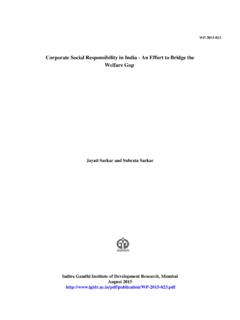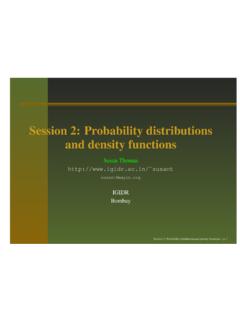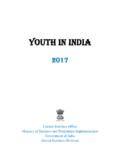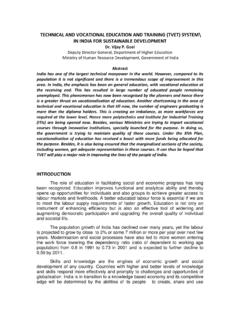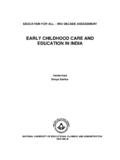Transcription of Youth Employment and Unemployment in India
1 WP-2011-009 Youth Employment and Unemployment in IndiaS. Mahendra Dev and M. VenkatanarayanaIndira Gandhi Institute of Development Research, MumbaiApril 2011 Employment and Unemployment in IndiaS. Mahendra Dev and M. VenkatanarayanaIndira Gandhi Institute of Development Research (IGIDR)General Arun Kumar Vaidya Marg Goregaon (E), Mumbai- 400065, INDIAE mail (corresponding author): in the share of Youth population due to demographic dividend or the Youth bulge seems tobe one of the sources of future economic growth in India . Although with increase in school and collegeenrolment rates, the proportion of Youth in the labour force has been declining, their high proportionsin the labour force indicate that the problem of Youth Unemployment and underemployment wouldremain a serious policy issue for many more years to come in India .
2 In this context, this paper examinesthe Employment and Unemployment situation of the Youth in India during the last two-and-half decadesviz., 1983 to 2007-08. It analyses the trends in labour force and workforce participation rates, Unemployment , joblessness, working poor, growth and Employment elasticities etc. The paper also offerspolicy recommendations for increasing productive Employment and reduction in Unemployment for theyouth. The poor employability of the workforce would hamper the advantages due to demographicdividend if measures are not taken to improve the educational attainment and skill development of : Youth Employment , Unemployment , skill development, joblessness, demographic dividend, literacy, school education, vocationaltrainingJEL Code:J21, J23, J10, J11 Acknowledgements:i1 Youth Employment and Unemployment in India S.
3 Mahendra Dev and M. Venkatanarayana I Introduction Young people are a major human resource for development, key agents for social change and driving force for economic development and technological innovation. But harnessing these resources is a major challenge. The Youth challenge is considered as the most critical of the 21st century s economic development challenge. Moreover, the decline in fertility rate has led to the bulge in working age population which is considered as the demographic dividend. It is a great concern that how this bulge in working age population presents the opportunities for growth and prosperity of a nation and the implications and opportunities of the bulge and how states are trying to respond.
4 The critical aspects of the challenge are mostly related to labour market entry where young people encounter difficulties in finding and maintaining a decent job. The growing large number of unemployed Youth is one of the most daunting problems faced by developed and developing countries alike (ILO, 2004, 2005b). Failure to integrate young people into the labour market has broader consequences for the future prosperity and development of countries. Thus the issue of Youth Employment and Unemployment features prominently on the international development agenda. It is a major focus of the Millennium Development Goals (MDGs) and was reaffirmed by the Ministers and Heads of Delegations participating in the High-Level Segment of the Substantive 2006 Session of the Economic and Social Council (ECOSOC) They committed to develop and implement strategies that give Youth everywhere a real and equal opportunity to find full and productive Employment and decent work1.
5 In the International Labour Conference (ILC) 2005, the discussion on Youth Employment concluded that there were many young workers who did not have access to decent work. A significant number of Youth are underemployed, unemployed, seeking Employment or between jobs, or working unacceptably long hours under informal, intermittent and insecure work arrangements, without the possibility of personal and professional development; working below their potential in low-paid, low-skilled jobs without prospects for career advancement; trapped in involuntary part-time, temporary, casual or seasonal Employment ; and frequently under poor and precarious conditions in the informal economy, both in rural and urban areas (ILO, 2005a).
6 Youth , defined by the United Nations as persons between the ages of 15 and 24, is a transitional period from childhood to adulthood, represents almost 18 per cent of the current global population. About eighty-four (84) per cent of the world s Youth live in developing countries (UN, 2007). According to ILO (2005b), in 2000 approximately a quarter of the world s estimated Youth population, or 238 million Youth , were reported to be living in Director (Vice Chancellor), Indira Gandhi Institute of Development Research, Mumbai Consultant, Centre for Economic and Social Studies, Hyderabad. 1 On Youth Employment in developing countries and policies see Chambers and Lake (2002), Godfrey (2003), Lam (2006), Rosas and Rossignotti (2005).
7 2 extreme poverty2. Low-income countries and lower-middle income countries, which together account for 80 per cent of the world s population of young people, are highly concentrated in the regions of sub-Saharan Africa and South Asia (ILO, 2005b). In 2005, around per cent of the Youth population of the world lived in the Asian and Pacific region. India has the largest Youth population in the world (UN, 2007). According to the Census of India 2001, the total population of India was 1, million. Nearly 40 per cent of the population was in the age group of 13 to 35 years. The number of Youth aged 15 to 24 years was million, which accounted for per cent of the whole population.
8 India contributes about 33 per cent of Youth population in the developing Asian countries (ADB, 2008). Increase in the share of Youth population due to demographic dividend or the Youth bulge seems to be one of the sources of future economic growth in India . The proportion of people in the age-group 15-24 years has increased over time. Although with increase in school and college enrolment rates, the proportion of Youth in the labor force has been declining, their high proportions in the labor force indicate that the problem of Youth Unemployment and underemployment would remain a serious policy issue for many more years to come in India .
9 The demographic dividend or Youth bulge is expected to increase the working age group and reduce the dependency ratio. In other words, the bulge in the working population will lead to acceleration in growth. However, recent studies have shown that the poor employability of the workforce due to deficit in educational attainment and health may hamper the advantages due to demographic dividend3. Since independence there has been a policy concern for Youth in India . The Planning Commission of India has recognised Youth as the most vital section of the community (Visaria, 1998). Also it had made a particular reference to Unemployment among the problems faced by the youth4.
10 Varied Youth welfare activities, including the promotion of sports, have been designed and developed. However, the higher relative incidence of Youth Unemployment has not received adequate attention (Visaria, 1998). The first National Youth Policy was formulated in 1988 in India . In 1985, the international year of the Youth , the Department of Youth Affairs and Sports, Ministry of Human Resource Development, Government of India , initiated a proposal to formulate a National Youth Policy which materialsed in 1988. The National Youth Policy 1988 recognised that the most important component of the Youth programme has to be the removal of Unemployment .


